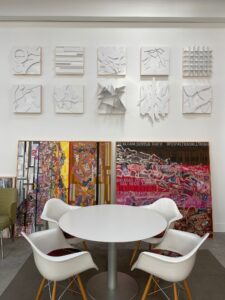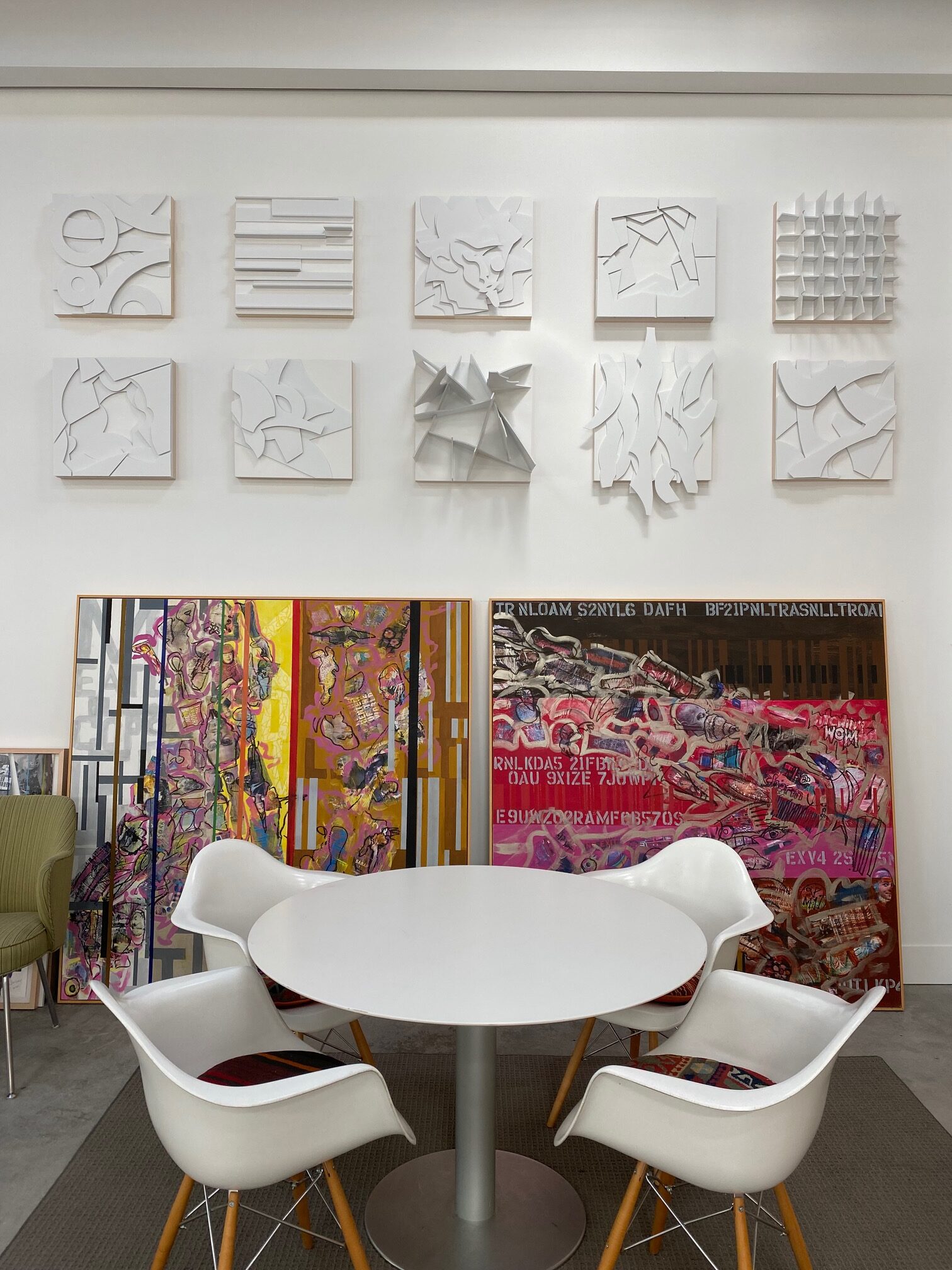FEATURE | By Bret Bradigan
Scott Johnson’s Art & Architecture Book Published

Architect Scott Johnson’s Art Barn
Architect Scott Johnson and his wife, Dr. Meg Bates, had a lively Covid-19 quarantine. Their bubble included their children; daughter, son-in-law and their two children, now ages one and two-and-half, in their recently built Ojai westside home.
The home was designed, in part, to accommodate large groups. It received its inaugural gathering with the performance of the Jack Quartet in 2019 for the Ojai Music Festival. “With this house, among other things, we wanted a room big enough (for such events),” Johnson said. One-hundred and twenty people listened to a concert with this renowned quartet.
It’s built for just such a purpose; Johnson’s daughter is a singer, his son-in-law a concert pianist and conductor, so the sounds of music were a theme throughout the strange days of 2020. “It’s been a crazy life,” he said.
It’s not the first home Johnson — best known as a designer of skyscrapers and other large buildings — has built for the more intimate patterns of family life. “Tracing through the houses I’ve built for our family I like to think I’ve been more responsible and flexible,” he said. “Meg loves roses and grows vegetables and she does the work, while my son is a doctor, he (also) went to Cordon Bleu and became a chef, so I knew I needed a good kitchen if we were going to have such capable people cooking for us.”
The melee of three generations under one roof did not stop Johnson’s creative output; he completed his fifth book in 2021, “Uncommon Ground: Notes on The Visual Arts + Architecture.” The book takes the reader on a sweeping journey through the connections between visual arts and architecture from the Romans and Renaissance to modern movements like Abstract Expressionism to the Postmodernists and Minimalists. He juxtaposes some of his own paintings with his architectural projects, in keeping with the book’s theme.
“I’ve been reactivating the fine arts part of my life, so this was definitely a pandemic project,” he said. “I had some time to look over what I thought I had learned, or mislearned, (and in some way) this book is a review of what I was learning.”
“While I consider myself reasonably savvy about the nature of practices in art and architecture, as an avid creator of both, I am interested how, in intent, and in means and methods, these practices occasionally align and frequently diverge,” Johnson writes in the foreward.
Johnson was born in the Salinas Valley and educated at Stanford University. Then transferring to Berkeley with graduate work at Harvard, he worked thereafter in New York City. His introduction to his future career was circuitous. “I was a freshman at Stanford, and it took me a year to realize they didn’t have an architecture department.” It was oriented to civil engineering. “They asked me my sophomore year if I would like to go to Italy. Yes! I was living in Florence with 80 other Stanford kids along with the friars (at the villa, which was also a monastery). Between Brunelleschi’s Duomo and the halls of the Uffizi, I was hooked. Then that took me right into Berkeley,” he said, which did have a prestigious architecture program.
He returned to California in 1983 to join the firm of Pereira Associates. His first big project was Fox Plaza, the 493-foot skyscaper made famous in “Die Hard” as Nakatomi Plaza. The building took four years from the drawing board to the ribbon-cutting; a comparable building now can take at least 10 years to complete.
In fact, Johnson was recently interviewed on Seth Rogen’s podcast. “He said it was his mother’s favorite film.” For good reason. “Die Hard” became a template for many modern action movies.
As Design Partner with Johnson-Fain, which grew out of William Pereira’s practice, Johnson, and his partner, Bill Fain, have collaborated on nearly 100 projects since Fox Plaza, most recently completing the First Americans Museum in Oklahoma City. For this monumental work of cultural remembering, Johnson collaborated with 39 Native tribes on the museum, which opened in September.
He has also lectured extensively around the world, before settling in Ojai for its “beautiful landscape and beautiful people” he said. Besides the main house, he and his family have built an Art Barn, where Johnson works on his visual arts project. He also built a pavilion, intended also for performances and gatherings. During the 2021 Ojai Music Festival, the Art Barn received the stamp of approval from conductor and composer John Adams.
One unanticipated, high-quality problem that emerged during the pandemic was with the 200 feet of frameless glass and the long rows of bookshelves, “I didn’t fully anticipate how dirty they can get,” he said about the home’s toddler-residents and their busy explorations.
Johnson was interviewed recently on the Ojai podcast, “Talk of the Town,” about his book, life and future projects. Here’s a sample of topics discussed.
OQ: On Art & Artists, post-pandemic:
SJ: I think it’s an existential moment; that people come out and they will be different. Mark Bradford said “I couldn’t be with my assistants, so I went in every day and made art. There was nowhere to go, so I just did it myself.” Rachel Feinstein sai,d “I’m not doing art, because I’m doing laundry, feeding all my kids and looking after them.” People’s circumstances are all different, but no one with a fine mind will come out and say “‘Let’s go back to where we were. That’s over.’”
Why is art valued as it is? Why are some works of art worth much more than architect-built homes? Re: A Mark Rothko painting selling for $250 million: Rothko was a complicated guy … he took his life at a certain point. Once he discovered his ethos, he stayed there. It was all about color saturation, and tones. He was always complaining about the forces acting on him to change, and he didn’t want to change. Didn’t know why he had to change. Why a painting of his would sell for that — or (Jean Michel) Basquiat … he sold one to someone for $25, now it sold for $80 million — it has something to do with the market, social dynamics that buyers feel art confers to them. It’s not so much content, as how they value possession of art.
OQ: On the rise of the arts and architecture as distinct disciplines: The Renaissance was the “Rise of the Ego.” Raphael, Leonardo, these guys were magnets for the Medici. It became important for the work to be done by Leonardo, for example.
On Daniel Burnham and working in the exclusive world of skyscrapers.The Chicago World’s Fair facing Grant Park? You’ve got the whole history of tall buildings in those three blocks.
OQ: On Ojai’s own Beatrice Wood and the early Modernists striking a blow for artistic freedom: (The) Bauhaus (Movement) intersects with lots of those movements. Then folks like Stalin and Hitler realized that the arts were signifiers and stepped in to control them as a part of their propaganda.
Early inklings of architecture as a career: I grew up always doing a lot — my father had a toolshed, I was always building things. I was born in the Salinas Valley, moved to the Peninsula. People thought of me as artistic, but I was also a rigorous student. I read Frank Lloyd Wright’s writings in high school, and between that and “The Fountainhead,” I mean, an architect (spoiler alert) who blows up his own work, how can you not like that when you’re 15-16?
On being a Los Angeles-based architect: From Mel’s Drive-In to the high restaurant period of the ‘80s, Disney Hall concert venues — Los Angeles is a buffett, not a fixed menu. I was 32, it was fun and I loved it, and something is happening and I wanted to do my own thing. It’s still the same here … you can invent the future.
On the book’s juxtaposing of fine art with architecture: I think of Peter Eisenman who, inspired by Minimalist artists, attempted to transport fine art into architecture, challenging us to think about it differently. I think of the ironies of Le Corbusier making a plan to flatten Paris and replace it with skyscrapers — this is the same guy who spent summers at the beach in a wood box of a building and made beautiful paintings.
Ojai’s good neighbor policy: While I built our house, I had an outdoor steel table moved up here and Jurgen Gramckow stored it for me in one of the barns on his farm across the street. The table I had designed weighed two tons and I had no idea how I would move it to the patio. He told me I should put plumbers tape on the paving and he came over with a crane, hoisted it over the house and dropped it in place. Imagine that.
It also turns out that Jurgen and I were in the same engineering class at Stanford in 1970. Small world!


Leave A Comment